Do your students get bored during scale practice? Do YOU get bored listening to your piano students practise scales?
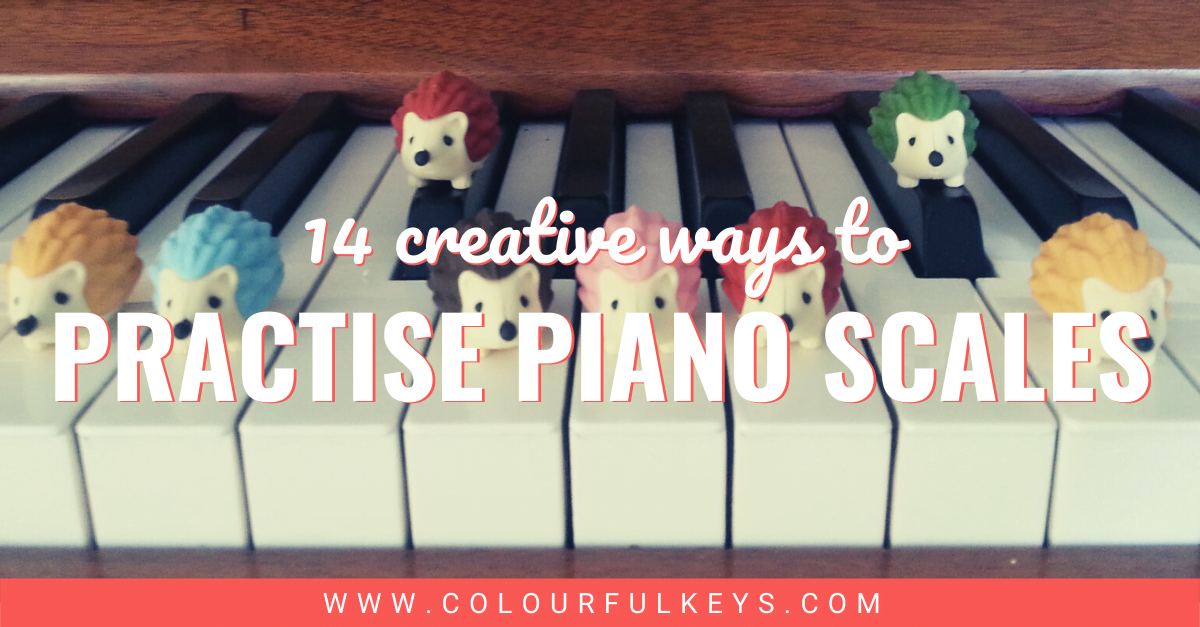
I know I’ve certainly been both the bored student and the bored teacher in that situation.
That’s why I’m always on the hunt for new scale drills I can use with my students. I think challenging piano students to play scales in new ways can keep their minds active and make their scale practice more effective.
I love finding a new idea to spice up scales that I can add to my scale-practice-memory-bank. Some of these ideas I come up with on the fly in lessons, and some are more planned out. Today I’m sharing some of my favourites so you can add them to your own memory bank.
Here are 14 different ways to practise piano scales. I hope you get a chance to use at least one this week!
If you’d rather jump straight to a category of piano scales drills, click on one of the links below.
The content in this article was first published separately in June 2016; May, July and October 2017; and February 2018. It was consolidated, edited and substantially updated in October 2021.
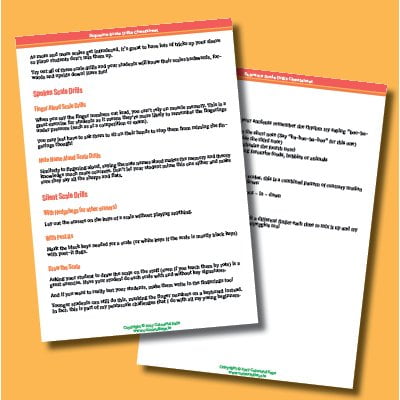
Subscribe to the newsletter and get the Supreme Scale Drills Cheatsheet
Enter your details to subscribe to the newsletter for piano teachers with information, tips and offers.
I hate spam as much as you do! I will only send you emails related directly to piano teaching and you can unsubscribe at any time.
But First, Tackling Scale-Practice Excuses
Let’s be real: No scale drill in the world will be worth a hoot if your students insist they “can’t remember” a scale once they leave your studio.
So before introducing any drills for piano scales practice, I make sure my students have these 2 resources:
- Scale reminder videos
- Scale booklets
Scale Reminder Videos
These scale reminder videos (or complete playlists) can be sent to anyone you wish. Send a YouTube link to your adult students, piano parents or a child-minder who helps with practice.
Major Pentascales Reminder Video Playlist
Major Scales Reminder Video Playlist
Harmonic Minor Scales Reminder Video Playlist
You may also wish to use these at your studio during lab or practice time if you do buddy lessons.
Scales Booklets
Scales booklets are just what they sound like: printable pages with the scales on them showing the notes on the keyboard and on the staff, plus the fingering for each hand.
There are many ways you can use scales booklets like these. For example:
- Print the whole booklet to include in your student’s practice folder.
- Print the booklet on card/cardstock, cut around each box and keep them as reference cards in your studio or for your student to have at home.
- Give your student one page or one scale at a time and send their parents a link to the corresponding video so they can figure out a new scale in their practice time (or remind themselves of an old one!)
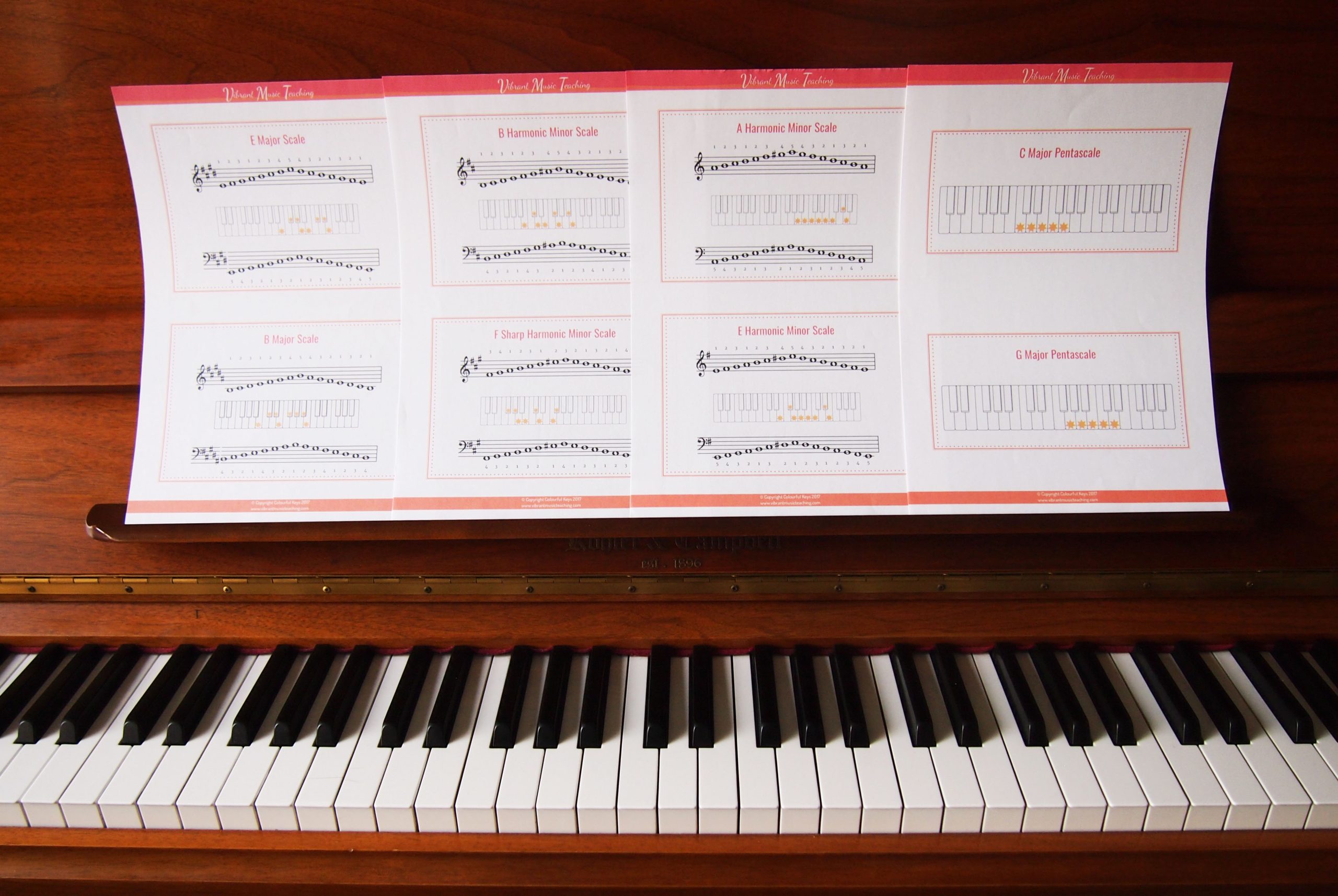
Members of the Vibrant Music Teaching family can access ready-made scales booklets in the VMT Library:
- Major Pentascales Booklet
- Minor Pentascales Booklet
- Major Scales Booklet
- Harmonic Minor Scales Booklet
- Melodic Minor Scales Booklet
- Blank Scales Worksheet
Not a VMT member? Scales booklets are a teeny-tiny fraction of the resources available to members. Check out the membership and sign up at the membership site.

Subscribe to the newsletter and get the Supreme Scale Drills Cheatsheet
Enter your details to subscribe to the newsletter for piano teachers with information, tips and offers.
I hate spam as much as you do! I will only send you emails related directly to piano teaching and you can unsubscribe at any time.
Practise Piano Scales with Apps
Do you use technology in your studio? There are so many music-related apps out there, but which are the most effective ones to help your piano students with scales practice?
Scale Drill #1: MusiClock
MusiClock is a wonderful app for piano scale practice. It’s basically a backing track app with different styles of music and a huge range of different scales.
- Every scale imaginable
- Backing track styles which actually sound good, current and fun
- Beautiful graphics to give it that “cool” factor (especially with teens and tweens!)
I made a quick demo video to show you the kind of things you can use this app for and how it works. There are tons of possibilities, but this should give you an idea of what you might do with this in lessons.
I especially love using this app for scale review during our buddy time. Having a track like this to play along with means that two students can stay together, and it also makes it easier for them to self-correct.
I always let my students choose the order of the scales and the track that we use, and I try not to count them in unless they’re really struggling to play together.
These little touches, and getting them to navigate the app themselves, all mean that it will be easier for them to use this in their practice at home. The more independent they are, the better.
Scale Drill #2: Piano Maestro
You’ve probably heard of Piano Maestro. But not everyone realises there’s a whole section on there with scales in every key and lots of different permutations.
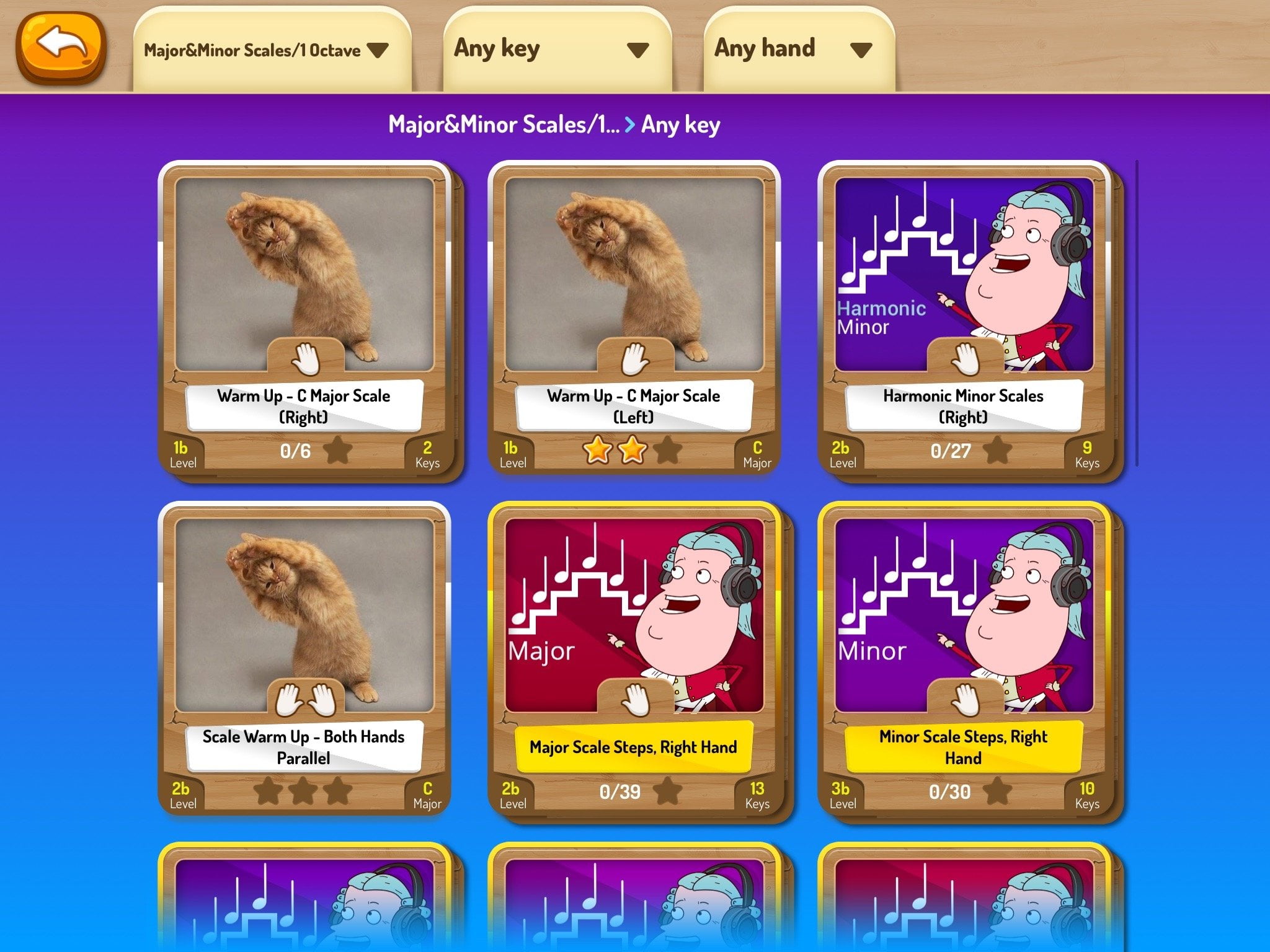
To get to this screen in Piano Maestro, click on “library” then “exercises”. From there you can select the type of scales and change the keys on each one by tapping on it and using the dropdown menu.
Kids are super jazzed when I bring out Piano Maestro at the start of a lesson – sortof like starting dinner with the dessert course. They might not even notice that this is still piano scales practice. Fabulously sneaky.
Scale Drill #3: iRealPro
In the video below, I show you some of the fabulous features in iReal Pro you can use to make practising scales more enjoyable.
If you’d like access to the playlists I mention in the video, you can download them for free to use in your own studio.
Scale Drill #4: Decide now!
If you’re drilling scales for an exam or other test, you’ll need your student to randomise their piano scales practice. Decide now! is THE solution. It’s fun, fast, and effective.
You can create your own wheels to randomise anything you want. Even better, there’s a setting to deactivate the options as you go so they don’t get repeated.
Some scales proving to be more challenging than others? Give them a greater weight than the others, so those scales come up more often when spinning.
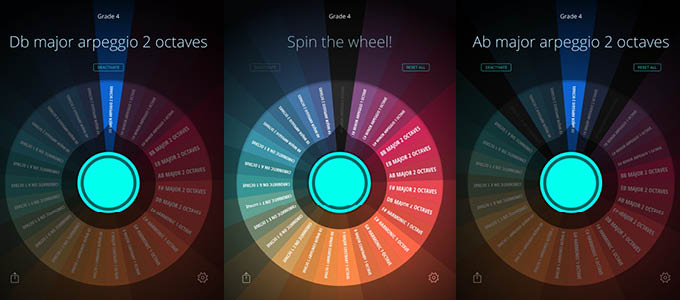
Now you can’t say you don’t have a better option than just “following the syllabus list in order”. So get spinning!
Piano Scale Drills On the Keys
Practising on the keys is probably the first thing teachers and students everywhere think of when you say the word “scales.”
But even at the piano, scale drills don’t have to be mindless repetition and tedious boredom. Reinforcing scales in many ways makes the concepts that much stickier.
Scale Drill #5: In Rhythms
This is the go-to way of changing up scale practice for many teachers. Here’s a few standard ones to get you started:
- Swung eighths (To help your students remember the rhythm try saying “boo-ba-boo-ba”)
- Swung eighths starting on the short note (Say “ba-boo-ba-boo” for this one)
- one-two-THREE (emphasise the third note)
- one-two-three-FOUR (emphasise the fourth note)
If you’re up for it – take it a step further and personalise the rhythms you’re using.
Ask your student for their favourite food (or sport, book, hobby, candy, artist, animal, etc), and then use that as the rhythm. So if a student says their favourite food is “lasagne and chips” that’s your new scale practice rhythm. I’ve had a lot of giggles with my students as a result of these rhythms.
Side note: I don’t recommend making them figure out the actual note values in the phrase. That just takes away the fun. And we need any extra fun we can get for scale practice.
Scale Drill #6: One-Fingered
You read that right. Ask your student to play their scale with just one finger. You can do this with one hand at a time, both hands, contrary motion, & arpeggios.
Start out with just finger 2 from each hand and then mix it up, asking for more and more obscure and odd combinations.
“Use finger 5 from your left hand and finger 3 from your right hand to play the B major scale.”
“Play B flat minor contrary motion using finger 2 in your right hand and finger 4 in your left hand.”
“Play F sharp major with regular fingering in the left hand and only finger 3 in the right hand.”
Does this make your head hurt a little? Mine too, but at least your student will have to think and can’t keep going on autopilot.
The more we have to think, the better we remember.
Scale Drill #7: Formula Patterns
Also sometimes known as Russian scales, this is a combined pattern of contrary motion and similar motion which goes as follows: up – out – in – up – down – out – in – down
This is obviously not for the faint of heart, and not for your beginning students. This style of scale playing does look pretty impressive though. Plus, it can make an intermediate student think about a scale in a new way after years of playing it.
The bonus of using formula patterns to practise scales is that it can have serious cool factor for some teens.
If you want to take it a step further, make up your own formula pattern – get as creative as you want!
Scale Drill #8: Hedgehogs
Ok, bear with me. We’re not talking about real hedgehogs.
I’m talking about these cute little Japanese erasers which fit perfectly on the piano keys.
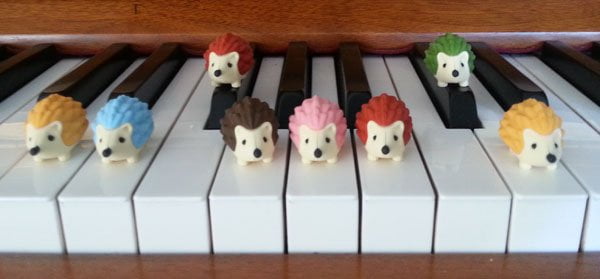
Getting your student to lay out a scale without playing anything is a fantastic way to switch off their muscle memory for a second and make her really think. If they can play every scale at warp speed but can’t tell you what notes are in it, they’re missing part of the value of scales.
Obviously it doesn’t have to be hedgehogs; you can use anything which fits nicely on the keys. Just make sure it’s something which can’t fall in between the keys. You don’t want to have to call your technician…
Scale Drill #9: Post-it Tabs
I use little post-it tabs to help my students map out the important keys in a particular scale. What we mark depends on the scale and what my student is struggling with at the time. It could be the black keys, the white keys (in F sharp major for example), the thumb-unders, the third fingers, etc.
I find this is especially useful for a student’s first contrary motion scales with several black keys. Here’s what it would look like for A major contrary motion:
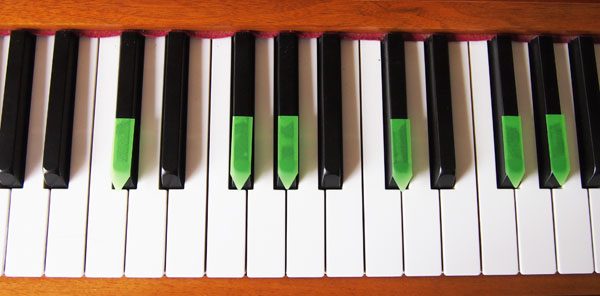
Your student can then play their scale on top of these stickies and use them as little landmarks on the way. I often stick these tabs at the top of the student’s assignment sheet so they can use their “training wheels” at home for the first week with a new scale.
Once they can successfully do the scale with the tabs, I take them away and tell them to imagine the coloured tabs are still there. Before playing any scale, you can now ask your student to imagine the stickies.
This gives them that extra level of focus to draw their attention to the right places.
Scale Drill #10: Making Scales Musical
Do your students play their scales like robots, hammering up and down the keys?
While it’s important to have lots of ways to make scale practice fun and more effective, there’s also something to be said for making scales interesting.
I’m here to remind you that piano scales can be beautiful. They should musical. And there’s one ingredient above all others which will make scales sound like real music: dynamics.
Dynamics are the key to unlocking so much beauty in the scales, arpeggios and other technical drills we ask our students to practise each day.
Add a crescendo here, a diminuendo there, and maybe even a ritenuto or an accelerando. Wake up your students’ ears and get them to listen to the music in their scales.
In this way, the scales themselves can breed curiosity and can be inherently motivating without any added incentives or whimsy.
Piano-less Scale Drills
In this type of practice, your student plays nothing…
…well, except in their imagination.
Mental practice is very valuable, and can be a great way to switch it up.
Have your student think through their scale, imagining playing each key. There are a few different ways to go about this…
Scale Drill #11: Finger Numbers
When you say the finger numbers out loud, you can’t rely on muscle memory. This is a great exercise for students as it means they’re more likely to remember the fingerings under pressure (such as at a competition or exam).
You may just have to ask them to sit on their hands to stop them from miming the fingerings, though!
Scale Drill #12: Note Names
Similarly to fingering aloud, saying the note names aloud makes the memory and theory knowledge much more concrete. Don’t let your student mime this one either, and make sure they say all the sharps and flats.
Want to level up the challenge factor? Turn on the metronome or a backing track and ask your student to visualise it in that tempo – you can try this in different note values as well. Ask them to start visualising the scale when you count them in, and at some point say “STOP!” and ask what note they are on.
Scale Drill #13: On Paper
Your students shouldn’t just know how to play their scales; they need to be able to write them too.
Asking your student to draw the scale on the staff (even if you teach them by rote) is a great exercise. Have your student do each scale with and without key signatures. And if you want to really test your students, make them write in the fingerings too!
If writing out scales on the staff is too difficult for the moment, younger students can still do this by writing the finger numbers on a keyboard instead.
Scale Drill #14: With Blocks
I came across the idea for these blocks through Mrs Miracle’s Musical Room while surfing Pinterest. What a great manipulative to add to my collection! I really like the simple black and white design matching the piano keys.
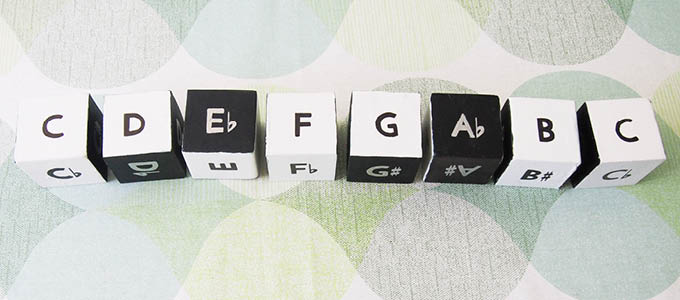
You can use these blocks to review scales quick-fire, quiz style. Or you could use them in groups and get teams to build as many different scales as they can in under a minute.
The possibilities are endless!
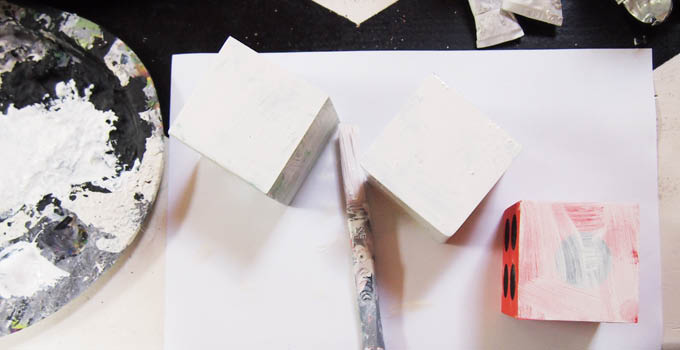
I made my set by painting foam dice like these. I painted a white undercoat, then the white and black backgrounds. When they were dry I used tracing paper to transfer the letter outlines and then paint markers to colour the actual letters.
If you’ve loved these ideas to jazz up piano scales practice, you’ll love the other ideas found on my centralised Music Theory hub page.
Bonus Scale Drill #15: Games
If you’ve known me for any time at all, you can probably guess that one of my favourite ways to make scales practice fun and effective with my piano students is using music theory games.
Members of Vibrant Music Teaching can access loads of scale games in the VMT Library, like Scale Engineer.
Not a member of Vibrant Music Teaching? Join today to get instant access to all the printables, courses, videos, tools, and community forums.

Subscribe to the newsletter and get the Supreme Scale Drills Cheatsheet
Enter your details to subscribe to the newsletter for piano teachers with information, tips and offers.
I hate spam as much as you do! I will only send you emails related directly to piano teaching and you can unsubscribe at any time.
Which piano scales drill will you try first?
Come back and tell me how it went in the comments below. I’d love to hear from you about the scales practice happening in your piano studio.
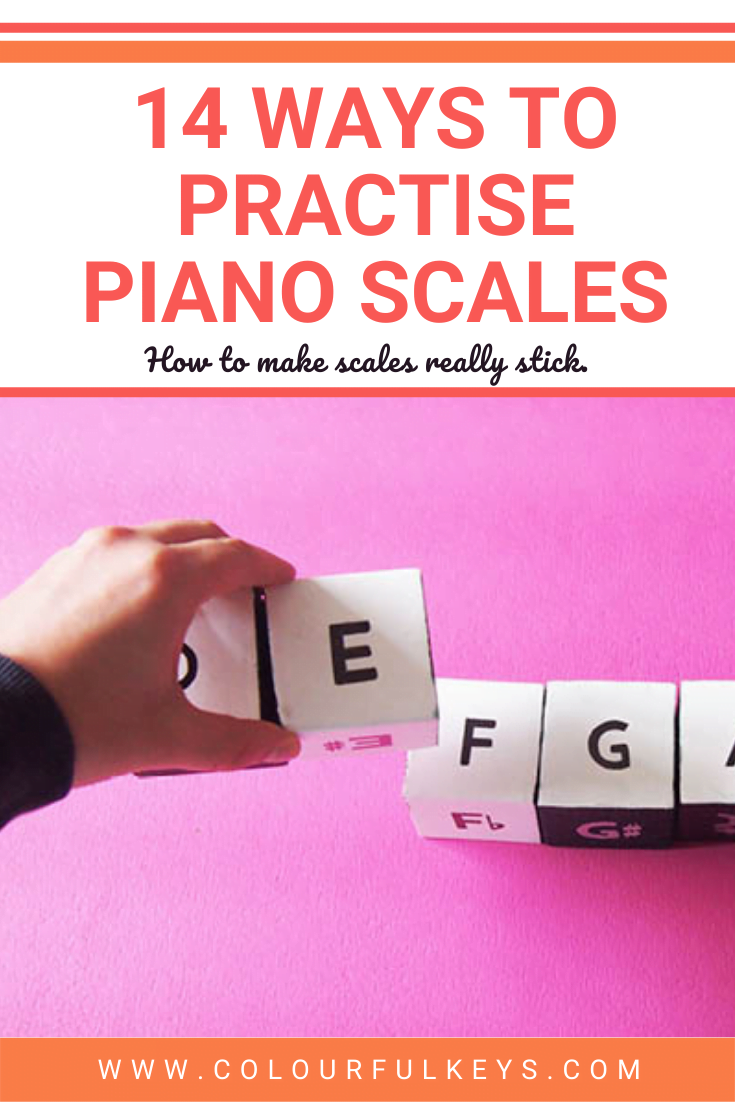
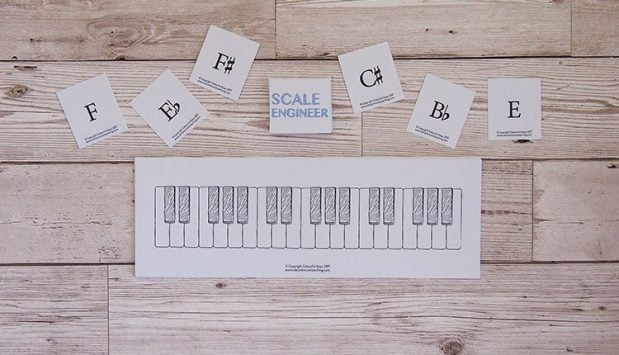
Thank you for all your wonderful free downloadables, clips and articles. I teach a small number of students and these are so often just what I am looking for. Saves me investing large sums in the larger collections of books.
Glad it was helpful Karen!
I like the videos! I would love 2 octave Hands together ones!. Also, the d minor harmonic scale cuts out after 19 seconds. Thanks
Thanks for sharing these wonderful downloads and videos, Nicola!!
You’re welcome!
With it being the “winter” season here in North Carolina (southern US) I’ve pulled this resource back out again for my beginners. They love the snowmen and I love the arrows, especially since one student this year did a camp where they “learned” piano and she plays everything in the LH opposite.
I just wanted to say that with a different student, I’ve had a blast taking it to the white keys and doing some investigation. Before we play I ask “Do you think it will change how it sounds, why or why not?” After we have played it in a couple of different white key groups, then we start a “list of observations” that help us figure out what makes it different. It’s a great way to start talking about semi-tones and tones.
Thanks for all you do to help us make lessons fun and engaging!
Hi Katye,
Thanks for commenting, that sounds great that you are exploring different ways to use the resource. How fun!
Warm Regards,
Gemma
Colourful Keys Community Assistant